Forums:
Our first hike of the year in this late spring was yesterday to Forgetmenot Ridge in Kananaskis Park, Alberta. The trailhead is a 45 minute drive west of here. Despite the VERY strong wind, I was surprised that a few of the pictures turned out reasonably in focus - the plants were always being blown around, and my camera hand often was too!
On the way up:




Comments
Lori S. (not verified)
Re: First hike of the year - Kananaskis Country, Alberta
Sat, 07/16/2011 - 12:43pmThe last shot in the previous set showed the highlight of the hike at this time in the season... the spectacular potentillas! I still haven't figured out exactly which of the 6 or so possiblities they might be, but I've decided to go with Potentilla uniflora. ??? (If anyone knows what they are, please speak up!!) Here are a few shots of the gorgeous plants, with flowers absolutely radiant in the brilliant light, and of their favoured scree slope habitat.
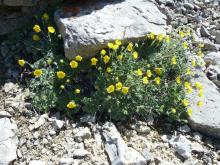
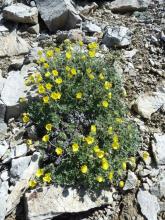
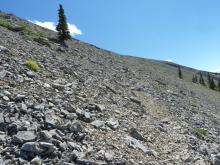
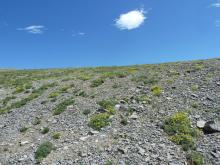
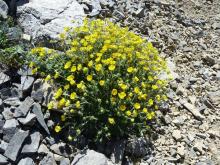
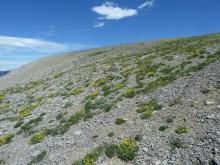
It's also the favoured habitat of Saussurea nuda var. densa, none of which were yet in bloom; some young plants and a close-up of the hairy foliage:
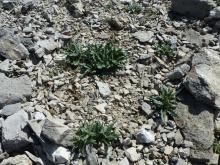
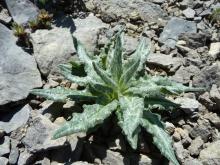
Delphinium glaucum, and Draba sp., showing seedheads, on the scree slope.
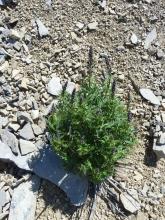

Lori S. (not verified)
Re: First hike of the year - Kananaskis Country, Alberta
Sat, 07/16/2011 - 3:12pmAnd up on the ridge...
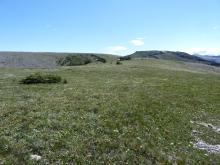
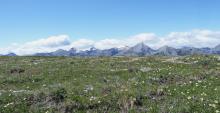
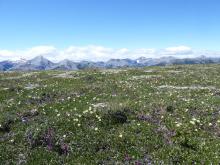
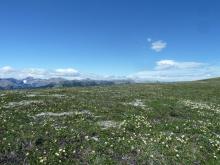
The wind was howling but, surprisingly, not as cold as I expected. Fleece jackets, gloves and Elmer Fudd hats (with ear flaps and chin straps) kept us reasonably comfortable, not to mention stylish. ;D There was still a bank of snow behind the kruppelholz (a frequent lunch spot) and many of the willows there had not even leafed out yet...



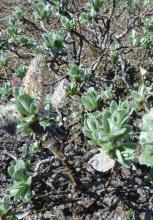
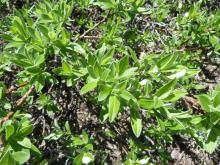
Lori S. (not verified)
Re: First hike of the year - Kananaskis Country, Alberta
Sun, 07/17/2011 - 11:33amAnd out on the scree flats, Oxytropis podocarpa, some already forming seedpods and many in bloom:
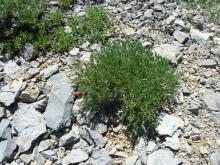
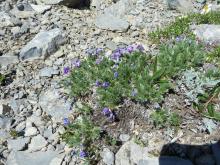
Hedysarum boreale var. mackenzii:

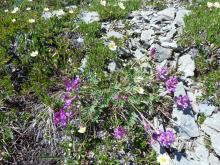
Minuartia austromontana is common - I always find it very interesting to see.
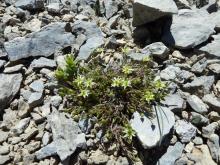
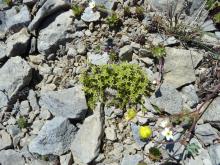

Campanula uniflora:

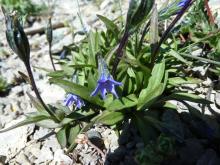
And one of my favourites, Silene uralensis ssp. attenuata:
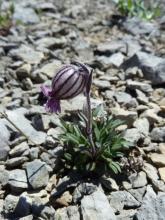
Mark McDonough
Re: First hike of the year - Kananaskis Country, Alberta
Sun, 07/17/2011 - 8:03pmLori, I'm enamored with Silene uralensis ssp. attenuata, what an adorable little munchkin! We've discussed this before ;) Are you able to grow Oxytropis podocarpa; looks like one worth growing for the nice compact mats of foliage alone, although the near blue flowers are great too.
Lori S. (not verified)
Re: First hike of the year - Kananaskis Country, Alberta
Sun, 07/17/2011 - 9:44pmYes, it's cute as a bug's ear!
I collected a tiny bit of seed last year of Oxytropis podocarpa, germinated it in the winter and have managed to keep the seedlings alive so far, and have planted a couple out in the tufa garden. As the places I see them virtually all limestone, I think the tufa should be the right environment for them... time will tell, I guess.
Lori S. (not verified)
Re: First hike of the year - Kananaskis Country, Alberta
Thu, 07/21/2011 - 7:42pmThe ubiquitous Dryas octopetala:
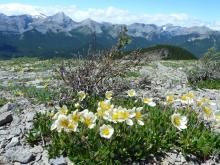
Physaria didymocarpa:
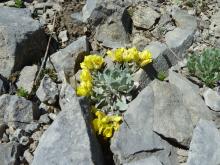
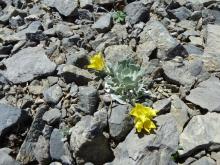
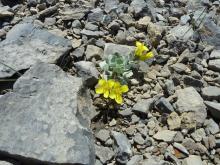
Eriogonum androsaceum:
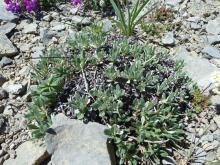
Tiny Gentiana prostrata:
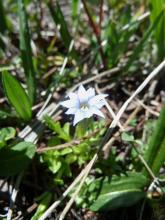
Myosotis asiatica (formerly M. alpestris):
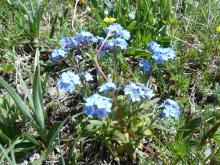
Rhodiola integrifolia, a rather orange-y one in flower and one that is brilliantly red in seed:
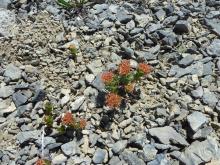
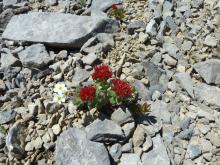
Flowers on the ridge:
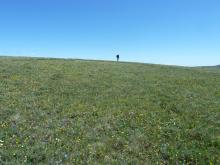
Lori S. (not verified)
Re: First hike of the year - Kananaskis Country, Alberta
Thu, 07/21/2011 - 8:08pmThe scene:
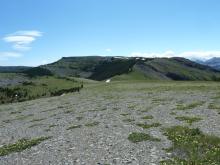
Leptarrhena pyrolifoliaCorrection: Saxifraga occidentalis (I'm always mixing these two up):Beautiful Erigeron grandiflorus (I think - please correct me if I'm wrong):
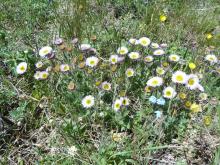
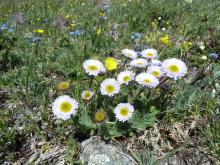
Abundant Zigadenus elegans in the turf:
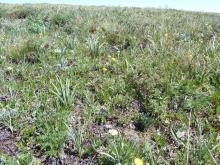
Androsace chamaejasme, in the turfy tundra and in the rock pavement:
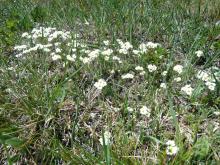
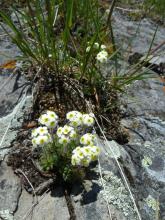
Erigeron compositus:
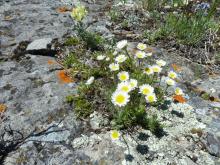
Approaching the saddle area:
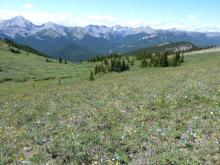
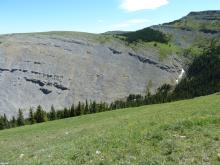
Richard T. Rodich
Re: First hike of the year - Kananaskis Country, Alberta
Thu, 07/21/2011 - 8:33pmBesides the plant life, I find the geology and plant communities equally interesting. It seems like in the high mountains there, there are low growing meadows and trees, but no mid size (or any size) shrubs. Is that true?
When I see a block of seemingly densely populated trees in the distance but still at near the tree line, is it like a forest, or is it like trees growing in an open yard (without a closed canopy)?
Lori S. (not verified)
Re: First hike of the year - Kananaskis Country, Alberta
Thu, 07/21/2011 - 8:42pmDown the warm, south-facing slope, out of the wind, Pulsatilla patens are still in bloom, and some gone to seed:

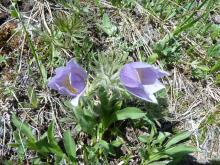
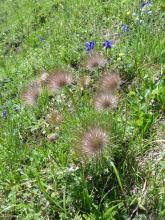
Dodecatheon conjugens, I think (as opposed to D. pulchellum) based on the pubescent leaves:
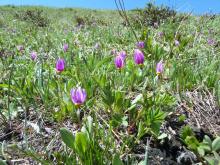
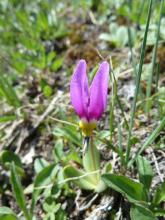
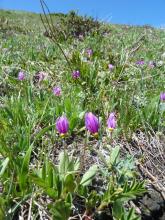
Anemone multifida:
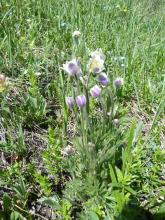
Anaphalis margaritacea:

Penstemon procerus:
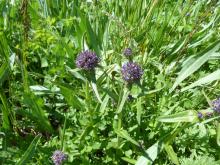
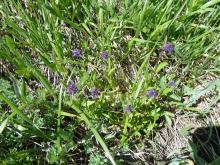
Lori S. (not verified)
Re: First hike of the year - Kananaskis Country, Alberta
Thu, 07/21/2011 - 9:04pmRick, I am only familiar with some of the areas around here so I'll describe them...
The area pictured is at tree line and slightly higher; the trees in the distance are definitely forest, but as they are subalpine fir, Engelmann spruce, and lodgepole pines (all conical in shape, and not very tall), there is not really any canopy. At lower elevations, the trees (same species) are taller and it is more shaded, and lower yet, there are deciduous trees - trembling aspen mainly - so there is more of a conventional canopy there.
Tree line in this dry area is marked by kruppelholz alpine firs that are short in stature but obviously old, as shown by the thick trunks - they are also usually pruned by the wind on the windward side. (Kruppelholz refers to stunted growth due to the conditions - weather and wind in this case (as opposed to the term, krummholz, which is used often but usually incorrectly, as it refers to genetic stunting)). The shrubs above tree line on this dry ridge are mainly Dasiphora fruticosa and dryads. The willows in the moist areas (e.g. north slopes behind kruppelholz) are up to about knee-high, at most.
In wetter areas here, tree line is often marked by alpine larch which then also peters out to kruppelholz.
In the high mountains, above tree line, there are no trees but only very low-growing shrubs at best (e.g. willows in wet areas; ericaceous shrubs; dryads, etc.).
Not a very complete picture - I know I'm missing all sorts of important points but I hope that helps!
Toole (not verified)
Re: First hike of the year - Kananaskis Country, Alberta
Thu, 07/21/2011 - 9:06pm;D ;D
Wonderful vistas and plants Lori. :o
Thanks so much for posting.
Cheers Dave.
Richard T. Rodich
Re: First hike of the year - Kananaskis Country, Alberta
Thu, 07/21/2011 - 9:51pmThanks Lori. What's a dryad? The nearest definition I can find is a generic plant that grows in dry and/or austere conditions. Seems to fit...
Lori S. (not verified)
Re: First hike of the year - Kananaskis Country, Alberta
Thu, 07/21/2011 - 10:06pmYou're welcome, Dave!
Rick, "dryad" is a common name for Dryas spp.... although your definition seems to fit too!
A spruce grouse down the slope from me (this photo is zoomed in)... from the chuckling and bleating sounds she was making, I'd guess she had her brood with her.
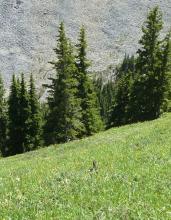
Delphinium bicolor; Myosotis asiatica with Rumex:
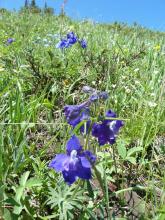
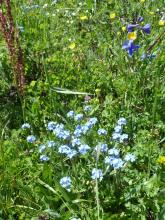
Back on the ridge, more Rhodiola integrifolia; Silene uralensis ssp. attenuata; a Dasiphora fruticosa bonsai:
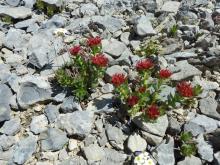
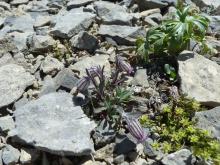
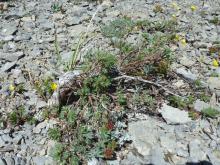
Lori S. (not verified)
Re: First hike of the year - Kananaskis Country, Alberta
Fri, 07/22/2011 - 3:29pmAnd wrapping up...
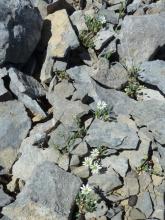
Cerastium beeringianum(?):
A good-sized mat of Silene acaulis, not yet in bloom:
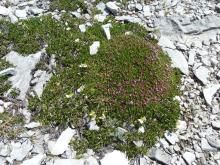
Ferns:
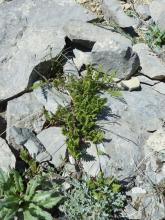
Retracing our steps, back into potentilla wonderland:
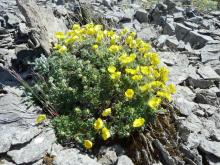
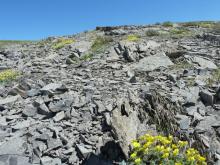
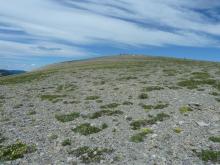
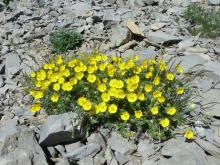
Heading down, Erigeron aureus in the sparse band of trees below the ridge, and Saxifraga bronchialis in the exposed rockface:
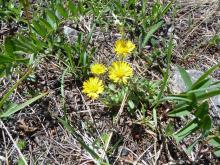
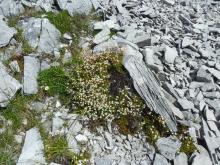
Lori S. (not verified)
Re: First hike of the year - Kananaskis Country, Alberta
Fri, 07/22/2011 - 3:38pmAnd in the meadow bordering the forest proper, Castilleja miniata:
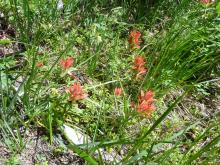
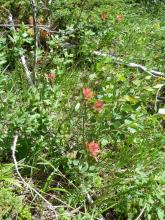
And in the broad river floodplain, the huge mats of Dryas drummondii were in bloom:
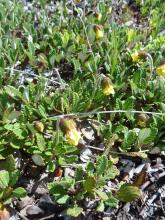
A nice white Castilleja in the floodplain:
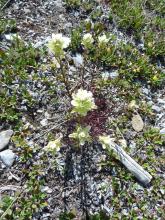
And after another bone-chilling crossing of 5 narrow, shallow channels of the "Big" Elbow River (there is usually only water flowing in 1 channel of the braided stream at this time - but due to very high snowfall last winter and a wet spring...) and the wider, deeper and fast "Little" Elbow River, we were on our way home after a satisfying first hike!
Luc Gilgemyn (not verified)
Re: First hike of the year - Kananaskis Country, Alberta
Sun, 07/24/2011 - 3:05amWonderful pictures Lori - despite windy conditions ! ;D
Thanks for taking us along on your hike !
Anne Spiegel
Re: First hike of the year - Kananaskis Country, Alberta
Sun, 07/24/2011 - 4:58amMe too, Mark. I remember seeing this when it was Silene apetala. I've tried growing it but seed doesn't seem very available. It germinated without problem, but getting it past the "mugs" in the summer was a big problem. The real reason to grow Oxytropis podocarpa, although the flowers are very good, is for the pods. They are huge and turn an almost mahoghany red-brown when ripe. It has problems here with the "mugs", not surprising for a snowmelt plant.
Trond Hoy
Re: First hike of the year - Kananaskis Country, Alberta
Tue, 07/26/2011 - 12:42amLori, I love ridges like that! Please keep on walking ;)
Lori S. (not verified)
Forgetmenot Update - August 5/11
Sat, 08/06/2011 - 7:20pmWell, I certainly hope to, Trond!
Another visit to Forgetmenot Ridge seemed timely yesterday, to see the next phase of bloom.
The water level was down in the "Little" Elbow River, to where we crossed easily near the parking area, and there was only one shallow "major" channel flowing in the "Big" Elbow... still as numbingly cold as usual though!
Whereas we had fairly scampered up the steep, rough slope last time (perhaps the 100 mph tailwind helped ;)), I have to admit we both laboured a bit more this time!
So, joining the hike in progress, the big climb is past and here we are traversing the scree slope... the site of the potentilla extravaganza of the last hike.

A new set of plants is delighting us now on the scree slope... Delphinium glaucum, Saussurea nuda var. densa, and the ubiquitous colourful inflated seedpods of Oxytropis podocarpa, very common up here, and shown in the last photo with the developing seedheads of Potentilla uniflora(?):
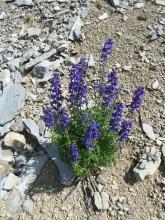
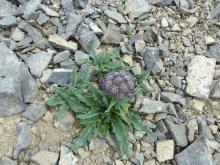

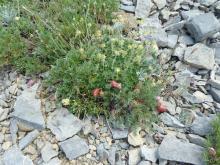
Crepis nana, not so common here... and a little haystack of astragalus/oxytropis/hedysarum stems, prepared for drying by a pika as winter food:
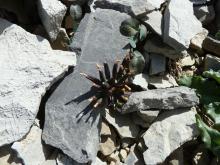
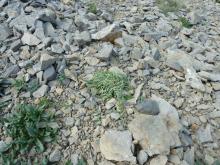
And the highlight of this bloom period, Eriogonum androsaceum (more on the confirmation of this species later)!

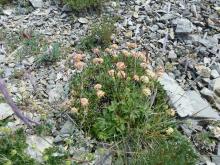

Lori S. (not verified)
Forgetmenot update - August 5/11
Sat, 08/06/2011 - 10:03pmMap lichen... or a cryptic message?!? ???

And more in flower when we have crested the ridge...
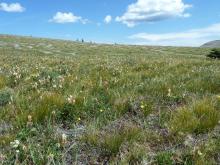
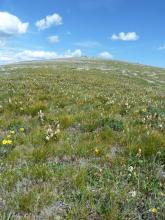
Packera contermina (formerly Senecio conterminus):
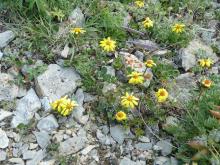
The bizarrely charming flowers (what proportions!)of Townsendia parryi:
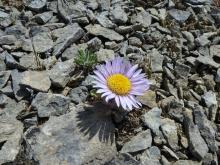
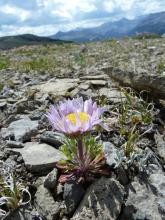
Senecio lugens:

Polygonum vivipara:
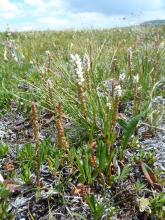
Diminutive Delphinium bicolor:
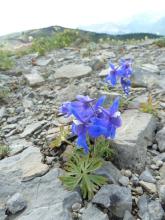
Hedysarum boreale and Dasiphora fruticosa:
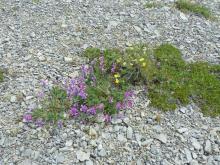
Lori S. (not verified)
Forgetmenot update - August 5/11
Sun, 08/07/2011 - 4:29pmZigadenus elegans, very common on the ridge:
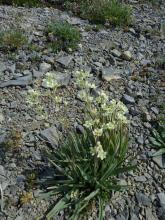
Anemone lithophila, in seed, as is this Rhodiola integrifolia, and Campanula uniflora, and Physaria didymocarpa:
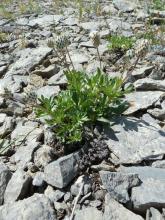
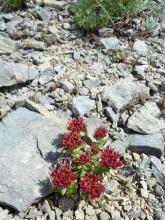
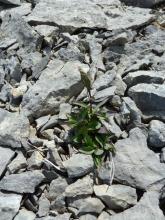
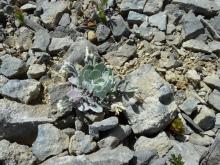
Dasiphora fruticosa:
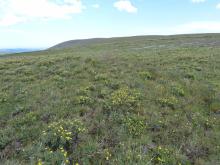

Lori S. (not verified)
Forgetmenot update - August 5/11
Sun, 08/07/2011 - 8:30pmArnica angustifolia:
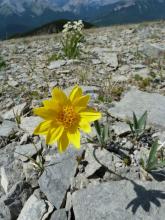
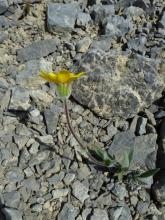
Cirsium hookerianum with Hedysarum sulphurescens:

Solidago multiradiata:
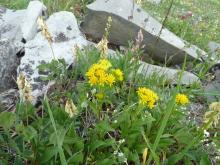

Salix sp. (I'll have to try to figure these out some day. :))
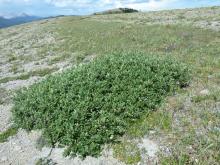
Gentiana prostrata, a tiny biennial, only a couple of centimeters tall:
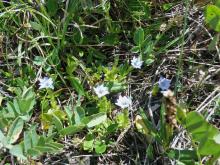
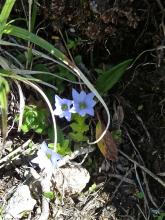
Scenery:
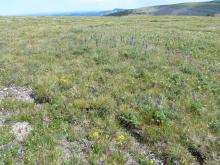
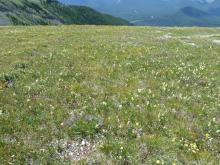
Lori S. (not verified)
Forgetmenot update - August 5/11
Sun, 08/07/2011 - 8:59pmSolidago spathulata:
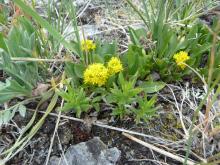
Penstemon procerus:
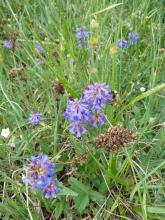
Chives (a native plant), Allium schoenoprasum var. sibiricum:

And in a slightly moister area (a possible seep) in the slightly lower area that we refer to as "the saddle" between the ridges and the summit approach, Pedicularis groenlandicum - the center photo shows why a common name is "elephant head":
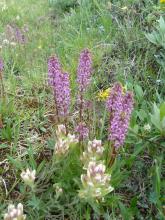
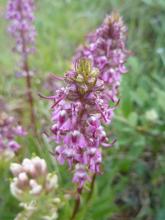
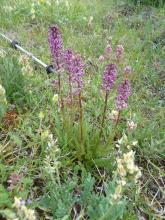
Myosotis asiatica:
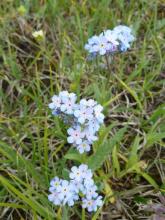
Floral richness, and silver willows in the saddle area:
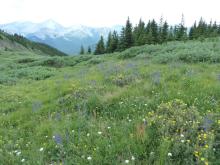
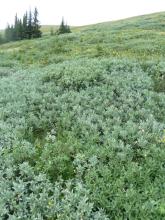
Cliff Booker
Re: First hike of the year - Forgetmenot Ridge, Kananaskis C...
Sun, 08/07/2011 - 11:46pmAnother wonderful hike, Lori ... all very much appreciated.
Lori S. (not verified)
Re: First hike of the year - Forgetmenot Ridge, Kananaskis C...
Wed, 08/10/2011 - 10:02pmThanks, Cliff!
Castilleja - I have the feeling that these photos captured characteristics that should be pretty distinct towards a species ID. Any opinions (... passing the buck ;D):
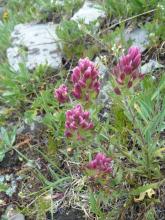
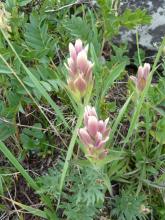
Unknown Aster(?) - another one to figure out:
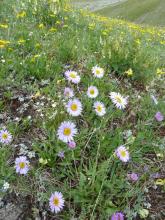
And growing on the slopes of the saddle area (while Eriogonum androsaceum grows on the scree of the ridge), here is what I have finally realized is Eriogonum ovalifolium var. ovalifolium (the variety according to Moss & Packer) - please correct me if I'm wrong!
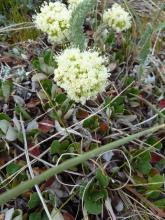
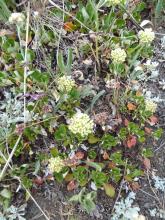
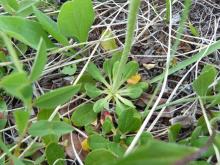

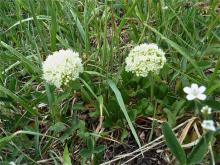
Aside from the foliage, these slides show what I believe are the characteristics of the flower detail that distinguish the two species:
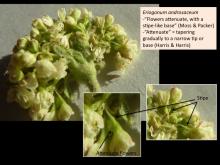
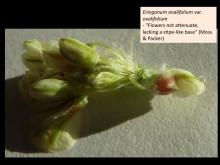
Please take a look and see if you agree!
cohan (not verified)
Re: First hike of the year - Forgetmenot Ridge, Kananaskis C...
Mon, 01/30/2012 - 11:46pmA great couple of hikes, Lori! So many gems, and fascinating some of the species that grow at so many altitudes, flowering over many months -Physaria flowers in May in the Kootenay Plains (11 or 1200metres?) (weirder yet, those that seem to flower at the same time down here and up there-- Delphinium glaucum seems close!)
The Eriogonums seem right based on those photos.. could you tell that from a visual inspection in person? Did you have to pull apart an inflorescence?
How tall does the Saussurea get in flower? Does it have a leafy flowering stem( I know I could just google it, not tonight..lol) it kind of reminds me of something I saw at the Icefields, but not in flower.. a largish plant for that site though... I'll have to dig for a photo and compare on google..
Leptarrhena pyrolifolia is interesting, not sure I've heard of this, though may be just forgetting..
Really nice flowerhead on the Anaphalis.. like the Packera contermina too-- which leaves belong to it? green, glabrous obovate?
Lori S. (not verified)
Re: First hike of the year - Forgetmenot Ridge, Kananaskis C...
Tue, 01/31/2012 - 5:35amI had to pull apart some flowerheads to look for stipes or no stipes to convince myself of the ID for E. androsaceum, but having done that, the various species are recognizable without going to that detail.
Saussurea nuda gets to about 1.5" tall, maybe 2" tall max, and a huge one would be perhaps up to 12" across, where I've seen it. Edit: Well, maybe I should really expand that height range up to about 5".
Actually, I suspect what I have been calling Leptarrhena pyrolifolia is actually a saxifrage... I've been meaning to go back through all my pix and figure this out and correct my labels!
A photo in this thread gives a better view of the hairy, angular leaves of Packera contermina:
http://nargs.org/smf/index.php?topic=343.msg3756#msg3756
cohan (not verified)
Re: First hike of the year - Forgetmenot Ridge, Kananaskis C...
Tue, 01/31/2012 - 10:57amWell, that will save me time looking at Saussurea... the plants I'm talking about are much larger, and I still have no idea what they are...lol